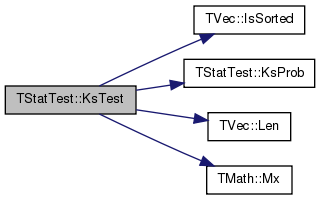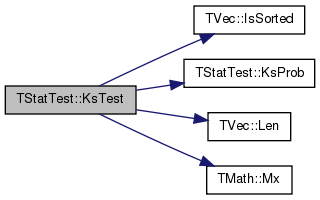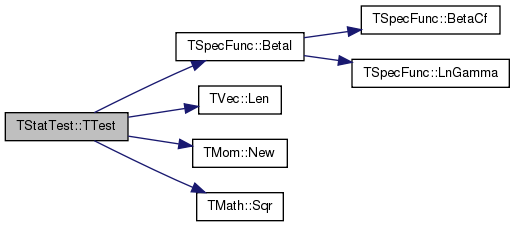|
SNAP Library 2.0, Developer Reference
2013-05-13 16:33:57
SNAP, a general purpose, high performance system for analysis and manipulation of large networks
|
|
SNAP Library 2.0, Developer Reference
2013-05-13 16:33:57
SNAP, a general purpose, high performance system for analysis and manipulation of large networks
|
#include <xmath.h>
Static Public Member Functions | |
| static void | ChiSquareOne (const TFltV &ObservedBinV, const TFltV &ExpectedBinV, double &ChiSquareVal, double &SignificancePrb) |
| static void | ChiSquareTwo (const TFltV &ObservedBin1V, const TFltV &ObservedBin2V, double &ChiSquareVal, double &SignificancePrb) |
| static void | TTest (const TFltV &ValV1, const TFltV &ValV2, double &TTestVal, double &TTestPrb) |
| static void | KsTest (const TFltV &ValV1, const TFltV &ValV2, double &DStat, double &PVal) |
| static void | KsTest (const TFltPrV &ValCntV1, const TFltPrV &ValCntV2, double &DStat, double &PVal) |
Static Private Member Functions | |
| static void | AveVar (const TFltV &ValV, double &Ave, double &Var) |
| static double | KsProb (const double &Alam) |
| void TStatTest::AveVar | ( | const TFltV & | ValV, |
| double & | Ave, | ||
| double & | Var | ||
| ) | [static, private] |
Definition at line 579 of file xmath.cpp.
References TVec< TVal, TSizeTy >::Len().
{
Ave=0;
for (int ValN=0; ValN<ValV.Len(); ValN++){
Ave+=ValV[ValN];}
Ave/=ValV.Len();
Var=0;
double ep=0;
for (int ValN=0; ValN<ValV.Len(); ValN++){
double s=ValV[ValN]-Ave;
ep+=s;
Var+=s*s;
}
Var=(Var-ep*ep/ValV.Len())/(ValV.Len()-1);
}

| void TStatTest::ChiSquareOne | ( | const TFltV & | ObservedBinV, |
| const TFltV & | ExpectedBinV, | ||
| double & | ChiSquareVal, | ||
| double & | SignificancePrb | ||
| ) | [static] |
Definition at line 609 of file xmath.cpp.
References TSpecFunc::GammaQ(), IAssert, and TVec< TVal, TSizeTy >::Len().
{
IAssert(ObservedBinV.Len()==ExpectedBinV.Len());
int Bins=ObservedBinV.Len();
int Constraints=0;
int DegreesOfFreedom=Bins-Constraints;
ChiSquareVal=0.0;
for (int BinN=0; BinN<Bins; BinN++){
IAssert(ExpectedBinV[BinN]>0);
double BinDiff=ObservedBinV[BinN]-ExpectedBinV[BinN];
ChiSquareVal+=BinDiff*BinDiff/ExpectedBinV[BinN];
}
SignificancePrb=
TSpecFunc::GammaQ(0.5*(DegreesOfFreedom), 0.5*(ChiSquareVal));
}

| void TStatTest::ChiSquareTwo | ( | const TFltV & | ObservedBin1V, |
| const TFltV & | ObservedBin2V, | ||
| double & | ChiSquareVal, | ||
| double & | SignificancePrb | ||
| ) | [static] |
Definition at line 626 of file xmath.cpp.
References TSpecFunc::GammaQ(), IAssert, and TVec< TVal, TSizeTy >::Len().
{
IAssert(ObservedBin1V.Len()==ObservedBin1V.Len());
int Bins=ObservedBin1V.Len();
int Constraints=0;
int DegreesOfFreedom=Bins-Constraints;
ChiSquareVal=0.0;
for (int BinN=0; BinN<Bins; BinN++){
if ((ObservedBin1V[BinN]==0.0) && (ObservedBin2V[BinN]==0.0)){
DegreesOfFreedom--;
} else {
double BinDiff=ObservedBin1V[BinN]-ObservedBin2V[BinN];
ChiSquareVal+=BinDiff*BinDiff/(ObservedBin1V[BinN]+ObservedBin2V[BinN]);
}
}
SignificancePrb=
TSpecFunc::GammaQ(0.5*(DegreesOfFreedom),0.5*(ChiSquareVal));
}

| double TStatTest::KsProb | ( | const double & | Alam | ) | [static, private] |
Definition at line 594 of file xmath.cpp.
Referenced by KsTest().
{
const double EPS1 = 0.001;
const double EPS2 = 1.0e-8;
double a2 = -2.0*Alam*Alam, fac = 2.0, sum = 0.0, term, termbf = 0.0;
for (int j=1; j <= 100; j++) {
term = fac*exp(a2*j*j);
sum += term;
if (fabs(term) <= EPS1*termbf || fabs(term) <= EPS2*sum)
return sum;
fac = -fac;
termbf = fabs(term);
}
return 1.0;
}

| void TStatTest::KsTest | ( | const TFltV & | ValV1, |
| const TFltV & | ValV2, | ||
| double & | DStat, | ||
| double & | PVal | ||
| ) | [static] |
Definition at line 667 of file xmath.cpp.
References IAssert, TVec< TVal, TSizeTy >::IsSorted(), KsProb(), TVec< TVal, TSizeTy >::Len(), and TMath::Mx().
{
IAssert(ValV1.IsSorted() && ValV2.IsSorted());
int i1=0, i2=0;
double CumSum1=0.0, CumSum2=0.0, Cdf1=0.0, Cdf2=0.0;
const double N1 = ValV1.Len();
const double N2 = ValV2.Len();
if (! (N1 > 0.0 && N2 > 0.0)) { DStat = 1.0; PVal = 0.0; return; }
DStat=0.0; PVal=0.0;
while (i1 < ValV1.Len() && i2 < ValV2.Len()) {
const double X1 = ValV1[i1];
const double X2 = ValV2[i2];
if (X1 <= X2) {
CumSum1 += 1;
Cdf1 = (CumSum1 / N1);
i1++;
}
if (X2 <= X1) {
CumSum2 += 1;
Cdf2 = (CumSum2 / N2);
i2++;
}
DStat = TMath::Mx(DStat, fabs(Cdf1 - Cdf2));
}
const double En = sqrt( N1*N2 / (N1+N2));
PVal = TStatTest::KsProb((En+0.12+0.11/En)*DStat);
}

| void TStatTest::KsTest | ( | const TFltPrV & | ValCntV1, |
| const TFltPrV & | ValCntV2, | ||
| double & | DStat, | ||
| double & | PVal | ||
| ) | [static] |
Definition at line 694 of file xmath.cpp.
References IAssert, TVec< TVal, TSizeTy >::IsSorted(), KsProb(), TVec< TVal, TSizeTy >::Len(), and TMath::Mx().
{
IAssert(ValCntV1.IsSorted() && ValCntV2.IsSorted());
int i1=0, i2=0;
double N1=0.0, N2=0.0, CumSum1=0.0, CumSum2=0.0, Cdf1=0.0, Cdf2=0.0;
DStat=0.0; PVal=0.0;
for (int i = 0; i < ValCntV1.Len(); i++) N1 += ValCntV1[i].Val2;
for (int i = 0; i < ValCntV2.Len(); i++) N2 += ValCntV2[i].Val2;
if (! (N1 > 0.0 && N2 > 0.0)) { DStat = 1.0; PVal = 0.0; return; }
while (i1 < ValCntV1.Len() && i2 < ValCntV2.Len()) {
const double X1 = ValCntV1[i1].Val1;
const double X2 = ValCntV2[i2].Val1;
if (X1 <= X2) {
CumSum1 += ValCntV1[i1].Val2;
Cdf1 = (CumSum1 / N1);
i1++;
}
if (X2 <= X1) {
CumSum2 += ValCntV2[i2].Val2;
Cdf2 = (CumSum2 / N2);
i2++;
}
DStat = TMath::Mx(DStat, fabs(Cdf1 - Cdf2));
}
const double En = sqrt( N1*N2 / (N1+N2));
PVal = TStatTest::KsProb((En+0.12+0.11/En)*DStat);
}

| void TStatTest::TTest | ( | const TFltV & | ValV1, |
| const TFltV & | ValV2, | ||
| double & | TTestVal, | ||
| double & | TTestPrb | ||
| ) | [static] |
Definition at line 646 of file xmath.cpp.
References TSpecFunc::BetaI(), TVec< TVal, TSizeTy >::Len(), TMom::New(), and TMath::Sqr().
{
/*double Ave1; double Var1;
AveVar(ValV1, Ave1, Var1);
double Ave2; double Var2;
AveVar(ValV2, Ave2, Var2);*/
PMom Val1Mom=TMom::New(ValV1);
PMom Val2Mom=TMom::New(ValV2);
double ave1=Val1Mom->GetMean();
double ave2=Val2Mom->GetMean();
double var1=Val1Mom->GetVari();
double var2=Val2Mom->GetVari();
int n1=ValV1.Len();
int n2=ValV2.Len();
TTestVal=(ave1-ave2)/sqrt(var1/n1+var2/n2);
double df=TMath::Sqr(var1/n1+var2/n2)/(TMath::Sqr(var1/n1)/(n1-1)+TMath::Sqr(var2/n2)/(n2-1));
TTestPrb=TSpecFunc::BetaI(0.5*df, 0.5, df/(df+TMath::Sqr(TTestVal)));
}
